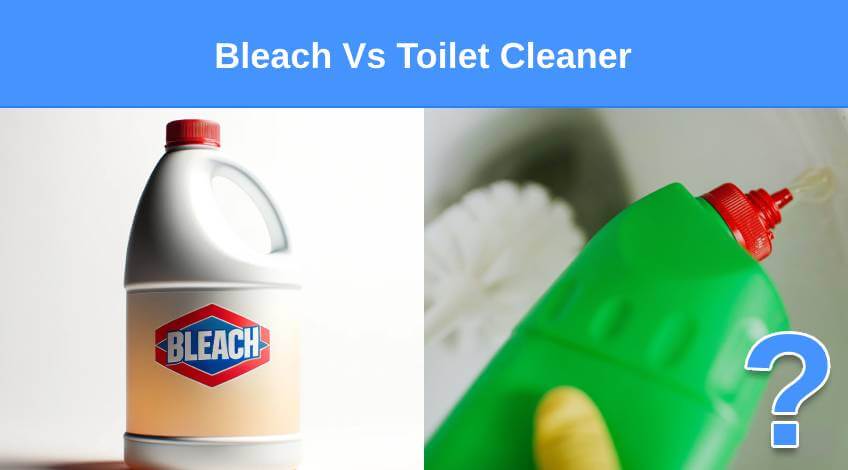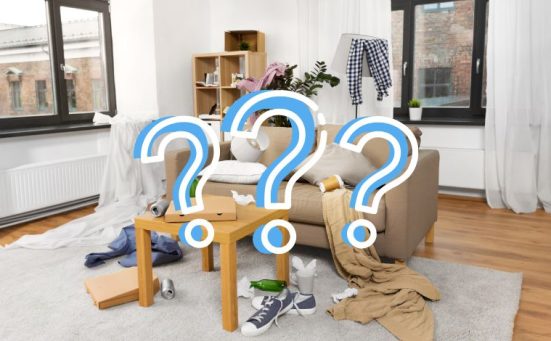
Bleach Vs Toilet Cleaner (what’s the difference & when to use them)
Although both bleach and toilet cleaners can whiten and disinfect, they’re best used in different situations.
Toilet cleaners are specifically made to clean and whiten toilets, containing ingredients like bleach, hydrochloric acid, and other disinfectants to tackle limescale and mineral buildup. On the other hand, bleach is a multi-purpose, potent chemical, useful not just in cleaning but also in whitening clothes and even killing weeds in the garden.
Now, let’s have a look into the details and learn more about when and how to use each of these products.
Bleach Or Toilet Cleaner?
Bleach and toilet cleaners, while both used in cleaning, serve distinct purposes. Let’s go over each one more thoroughly.
Bleach
Bleach, typically referring to chlorine bleach, primarily contains sodium hypochlorite. It’s known for its powerful disinfecting and whitening properties.

Excellent for removing stains and killing bacteria, viruses, and mould[1], bleach is a go-to for tough cleaning jobs. However, its potency means it can be corrosive and may damage certain materials and surfaces.
When using bleach:
- Never mix with other cleaning agents, especially ammonia or acids, to avoid releasing toxic gases.
- Use in well-ventilated areas and wear gloves for skin protection.
- Dilute appropriately with water.
- Store safely away from children and pets.
- Domestos White & Sparkle Thick Bleach cleans and disinfects surfaces around your home
- Unstoppable in the battle against germs, Domestos bleach eliminates 99.99% of bacteria and viruses*
Toilet Cleaner
Toilet cleaners are specially formulated for toilets, often containing a mix of hydrochloric acid, bleach, and other disinfectants.

They excel in removing hard water stains, mineral deposits, and bacteria found in toilets. Plus, they usually smell much better than bleach!
While effective, their acidic nature means they should be handled with caution due to their corrosive potential.
When using toilet cleaners:
- Handle with care, as they can be corrosive.
- Ensure good ventilation in the bathroom.
- Store safely, away from children and pets.
No products found.
Can You Use Both Bleach And Toilet Cleaner At The Same Time?
Mixing bleach and toilet cleaner is dangerous.
They can release harmful gases like chlorine gas, which is damaging to the respiratory system. This is why it’s hard to breathe after using both in an intense cleaning session.
Always use bleach and toilet cleaner separately and ensure the area is well-ventilated before starting the cleaning process.
Is It Okay To Use Bleach In The Toilet?
Using bleach in the toilet can be effective for disinfecting and removing general surface stains.
However, it’s not always the best choice for tougher stains or mineral deposits. Also, many experts believe that the chemicals in bleach can be so strong that it will erode the materials of your toilet, and affect your pipes and plumbing negatively.
If you really want to use bleach in the toilet, be sure to only use a small amount and dilute it appropriately. Never mix it with other cleaning agents, remember to wear gloves, and ensure good ventilation in the bathroom to avoid inhaling fumes.
TIP: Using bleach in the toilet can be dangerous. If you really want to use a stronger chemical, look for toilet cleaners that contain bleach.
Is It Okay To Use Toilet Cleaner To Clean Other Surfaces?
Toilet cleaners are formulated specifically for the type of stains and residue found in toilets and may not be suitable for other surfaces.
Just remember, a toilet cleaner can also contain bleach, a potent ingredient, among other things. Hence, the harsh chemicals can damage other materials like metal, wood, or certain plastics.
To prevent damage, only use the cleaner in the toilet! Depending on the type of toilet cleaner you have, some may also be multi-purpose and can clean other things in the bathroom, such as floor tiles and showerheads.
It’s best to use surface-specific cleaners for other areas of your home to avoid damage and ensure effective cleaning.
Other Ways To Use Bleach
Bleach is an extremely versatile cleaning agent that goes beyond just whitening clothes or disinfecting surfaces.
Here are some other ways you can use bleach:
- Sanitising Kitchenware
Diluted bleach can be used to sanitise dirty kitchenware like the chopping board you use for handling raw meat and fish. - Removing Mould And Mildew
Bleach can be very effective in removing mould, especially from bathroom tiles and grout. - Killing Weeds
Spraying bleach on weeds can kill the pesky weeds in your garden. Because of its strong chemicals, it will take a longer time for the weeds to grow again. - Disinfecting Waste Containers
To eliminate odours and bacteria, wash rubbish bins with a bleach solution.
So, Which One’s Better?
Bleach and toilet cleaner, while both powerful cleaning agents, have distinct uses and should be handled accordingly.
Bleach is a versatile disinfectant suitable for a range of purposes, from laundry to gardening. On the other hand, toilet cleaners are specifically designed for toilet bowls, tackling stubborn stains and bacteria.
It’s crucial to use them correctly and safely, keeping in mind that mixing these products can be dangerous. By understanding and respecting the differences between these two cleaners, you can maintain a clean, hygienic, home!
Do you have questions? Ask away!
SEE ALSO: Can You Use Household Bleach On Your Laundry?
Frequently Asked Questions
You should use toilet cleaner for specific toilet cleaning tasks like removing hard water stains and mineral deposits. Bleach, being more versatile, can be used for a variety of cleaning jobs, including disinfecting surfaces and whitening clothes, but may not be as effective as toilet cleaner for some specific toilet issues.
Yes, bleach can damage toilets. Its harsh chemicals can potentially erode the materials of your toilet, affecting the pipes and plumbing negatively. It’s effective for general disinfection and surface stain removal but may not be the best choice for tougher stains or mineral deposits.
The choice between vinegar and bleach depends on the cleaning task. Vinegar is a natural, non-toxic cleaner great for removing mildew and general cleaning. Bleach is a stronger disinfectant, effective against bacteria, viruses, and mould. However, bleach is harsher and should be used carefully.
The typical ratio of bleach to water for cleaning purposes is about 1:4 – that is, 1 part bleach to 4 parts water. This dilution is effective for general disinfection and cleaning tasks, but always ensure the area is well-ventilated and wear gloves for protection.
A toilet bowl cleaner is used by applying it directly to the interior surfaces of the toilet bowl, focusing on areas with stains and mineral deposits. After application, it’s usually left to sit for a few minutes to break down the stains before scrubbing with a toilet brush and flushing to rinse. It’s important to handle with care due to its potentially corrosive nature and ensure good ventilation during use.
Also, follow us on Pinterest ...




